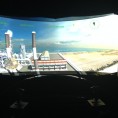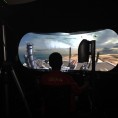How can we provide a “moving experience” through VR without having to use a full-scale motion platform?
Could a compact and relatively low-cost “motion seat” provide some of the same benefits, thus reducing cost, complexity, space & safety requirements?
Despite considerable advances in Simulation and Virtual Reality (VR) technology, it largely remains an open problem how to provide a convincing and embodied sensation of really being present and immersed in large virtual spaces, and navigating through them effectively without excessive disorientation and motion/simulator sickness. This is particularly true when the goal is to develop cost– and space-efficient solutions and physical space is limited, such that virtual navigation cannot be enabled by physically walking or moving-base motion simulators.
In collaboration with
Christie, a large audio-visual and VR system company, we jointly perform research into
innovative “motion seats” that allow for small-scale user motion and vibrations. The goal is to devise more compact and cost-effective ways to enhance the user experience (e.g., perceived realism, immersion, self-motion perception) as well as task-specific performance in simulators.
Initial qualitative research is used to identify key design decisions and outline requirements. This helps to guide the design and iterative refinement of both the motion seat and suitable experiments to investigate its effectiveness. Together, this will lead to a working prototype of a motion seat and demonstrator, scientific analysis and reports, and guidelines for possible future research and development. This project will enable and inspire more affordable yet effective simulators.
Reducing the reliance on large, heavy, and costly moving-base simulators can further enhance user acceptance, safety, and accessibility to wider audiences while reducing cost, space, and technical support needs.
This could provide benefits for both use single-user systems (e.g., arcades, home-based premium games, flight simulators or telepresence/remote operation systems) and multi-user systems (e.g., large format digital theatres, next-generation movies, and theme parks).
Media Gallery
Project videos
 This video gives a first glimps of a gamified experiment that we designed, where users can use either a Leap motion controller or a 2-handed joystick interface to control a helicopter (quatrocopter) flythrough in Virtual Reality. This demo illustrates flying through a Mediterranean market place (which was the training phase in one of our studies), projected on a Christie 2-projector VR simulator.
This video gives a first glimps of a gamified experiment that we designed, where users can use either a Leap motion controller or a 2-handed joystick interface to control a helicopter (quatrocopter) flythrough in Virtual Reality. This demo illustrates flying through a Mediterranean market place (which was the training phase in one of our studies), projected on a Christie 2-projector VR simulator.

Related Publications
http://ispace.iat.sfu.ca/wp-content/plugins/zotpress/
37904
Hashemian, Abraham M., and Bernhard E. Riecke. 2017. “Rotate and Lean: Does Leaning toward the Target Direction Improves the Virtual Reality Navigation?” Poster presented at the Second International Workshop on Models and Representations in Spatial Cognition, Tübingen, Germany, April 6.
(Download)
37904
Kitson, Alexandra, Timofey Y. Grechkin, Markus von der Heyde, and Bernhard E. Riecke. 2017. “Navigating Virtual Environments – Do Physical Rotations Aid in Orientation?” Poster presented at the Second International Workshop on Models and Representations in Spatial Cognition, Tübingen, Germany, April 6.
(Download)
37904
Nguyen-Vo, Thinh, Bernhard E. Riecke, and Wolfgang Stuerzlinger. 2017. “Investigating the Effect of Simulated Reference Frames on Spatial Orientation in Virtual Reality.” Poster presented at the Second International Workshop on Models and Representations in Spatial Cognition, Tübingen, Germany, April 6.
(Download)
37904
Nguyen-Vo, Thinh, Bernhard E. Riecke, Wolfgang Stuerzlinger, Duc-Minh Pham, Ernst Kruijff, and Riecke. 2020. “NaviBoard and NaviChair: Limited Translation Combined with Full Rotation for Efficient Virtual Locomotion.” Talk presented at the IEEE Virtual Reality 2020, Atlanta, GA, USA.
https://youtu.be/JCYL2qVFO6M.
37904
Hashemian, Abraham M., Alexandra Kitson, Thinh Nguyen-Vo, Hrvoje Benko, Wolfgang Stuerzlinger, and Bernhard E. Riecke. 2018. “Investigating a Sparse Peripheral Display in a Head-Mounted Display for VR Locomotion.” In
2018 IEEE Conference on Virtual Reality and 3D User Interfaces (VR), 571–72. Reutlingen, Germany: IEEE. https://doi.org/10.1109/VR.2018.8446345.
(Download)
37904
Nguyen-Vo, Thinh, Bernhard E. Riecke, and Wolfgang Stuerzlinger. 2018. “Simulated Reference Frame: A Cost-Effective Solution to Improve Spatial Orientation in VR.”
2018 IEEE Conference on Virtual Reality and 3D User Interfaces (VR) (Reutlingen, Germany), 415–22. https://doi.org/10.1109/VR.2018.8446383.
(Download)
37904
Nguyen-Vo, Thinh, Bernhard E. Riecke, Wolfgang Stuerzlinger, Duc-Minh Pham, and Ernst Kruijff. 2018. “Do We Need Actual Walking in VR? Leaning with Actual Rotation Might Suffice for Efficient Locomotion.” Poster presented at the Spatial Cognition 2018.
(Download)
37904
Nguyen-Vo, T., Riecke, B. E., & Stuerzlinger, W. (2017).
Moving in a Box: Improving Spatial Orientation in Virtual Reality using Simulated Reference Frames. 207–208. https://doi.org/10.1109/3DUI.2017.7893344
(Download)
37904
Freiberg, Jacob. 2015. “Experience Before Construction: Immersive Virtual Reality Design Tools for Architectural Practice.” MSc Thesis, Simon Fraser University.
https://summit.sfu.ca/item/16052.
(Download)

 This video gives a first glimps of a gamified experiment that we designed, where users can use either a Leap motion controller or a 2-handed joystick interface to control a helicopter (quatrocopter) flythrough in Virtual Reality. This demo illustrates flying through a Mediterranean market place (which was the training phase in one of our studies), projected on a Christie 2-projector VR simulator.
This video gives a first glimps of a gamified experiment that we designed, where users can use either a Leap motion controller or a 2-handed joystick interface to control a helicopter (quatrocopter) flythrough in Virtual Reality. This demo illustrates flying through a Mediterranean market place (which was the training phase in one of our studies), projected on a Christie 2-projector VR simulator.




